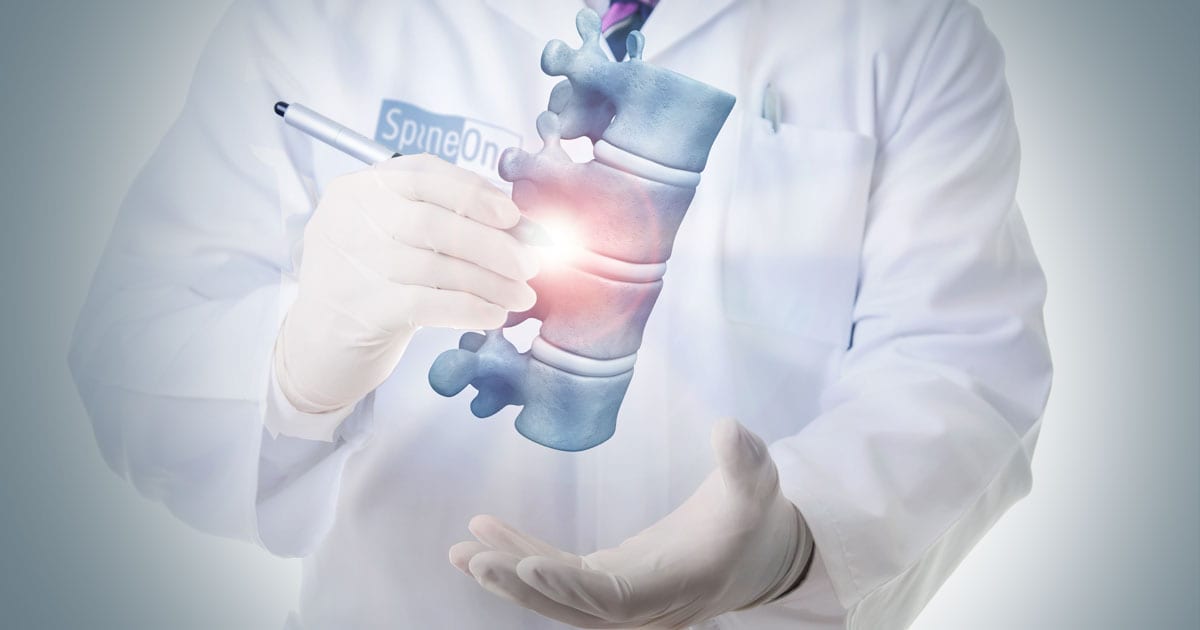SpineOne is Denver’s Low Back Pain Specialist
Low back pain affects most of us, and can have a very negative impact on the quality of our lives. Up to 80% of Americans will suffer from some form of back pain in their lives, with the severity ranging from inconvenient to debilitating. SpineOne has been treating lower back pain in Denver for almost 20 years, and has developed both a team of specialists, and a comprehensive medical center designed to address back pain quickly and effectively.
SpineOne treats low back pain with a combination of conservative treatments, physical therapy, injections, and other minimally-invasive procedures. These treatments offer a way to manage back pain without invasive surgery or reliance on habit-forming medication. And all of these options are available for same-day consultations.

What are the Symptoms of Low Back Pain?
Low back pain can present with a wide variety of symptoms, ranging from mild an inconvenient, to severe and debilitating. Lower back pain may start after an accident or injury, or may start without any apparent cause. This type of back pain may be experienced with different symptoms, such as:
- A dull or aching pain specific to the lower back
- Burning pain that starts in the low back and moves into the legs
- Numbness or tingling in the back or legs
- Muscle spasms and tightness in the lower back, buttocks, and hips
- Pain that seems worse after prolonged sitting or standing
- Difficulty transitioning from standing to sitting, including standing up straight and walking.
What Causes Low Back Pain?
Your spine is a large and complex structure. It supports your entire body, from your low back to your neck, and absorbs the shock of every step and every fall. Your spine is sturdy enough to support your body, and mobile enough to accommodate your movements. With the complex and important nature of your spine, it can be susceptible to many different injuries and degenerative conditions. Some of the most common causes of back pain SpineOne sees in our patients include:
- Muscle Strain & Sprain
- Sciatica
- Spine Alignment Issues
- Poor posture
- Herniated Disc (also known as a “Bulging Disc”)
- Spine Arthritis
- Facet Joint Pain
These causes of low back pain can result in minor pain, tingling and numbness, muscle spasms and (sometimes) severe, debilitating pain.
Are there Risk Factors for Low Back Pain?
Back pain can strike at any time, and will affect most of us at some point. Sometimes it’s after an injury, sometimes it starts for no apparent reason. But there are factors that may increase your risk of experiencing low back pain. The risk factors are:
- Age
- Lack of exercise
- Excess weight
- Diseases
- Improper lifting
- Psychological conditions
- Smoking
If you have questions or concerns about any of these risk factors, our providers are available to answer questions.
Should I go to the Emergency Room?
If back pain is associated or combined with one or more of the following signs and symptoms, this may be a red flag that medical intervention is necessary:
- Fever: Could indicate an infection in your spine
- Incontinence or bladder problems: Could indicate cauda equine syndrome or spinal cord compression
- Numbness or loss of sensation in the pelvis or sphincter area: Could indicate cauda equine syndrome or spinal cord compression
- Major motor weakness: An indication of nerve root compression
- Tenderness to touch or pressure: Could indicate fracture or infection
If you are in need of evaluation for any of these conditions, please call our medical center and clearly discuss the seriousness of your symptoms. Or, if in doubt, please proceed to an emergency room or call 911.
Diagnosing Low Back Pain
 Understanding the underlying cause of low back pain often means an extensive look at a patient’s history, habits, and the nature of what they’re feeling. SpineOne takes a holistic and nuanced approach to diagnosing back pain to understand not only symptoms, but also understanding our patients and their needs.
Understanding the underlying cause of low back pain often means an extensive look at a patient’s history, habits, and the nature of what they’re feeling. SpineOne takes a holistic and nuanced approach to diagnosing back pain to understand not only symptoms, but also understanding our patients and their needs.
Consultation & Examination
The foundation of our diagnostic process is the initial exam and discussion of our patient’s history, activity level, sleep habits, and any activity or injury that may have brought them to SpineOne. During this initial consultation our doctors learn more about the patient’s condition, and begin to outline a wellness program.
Palpation
Your SpineOne doctor will feel by hand (also called palpation) along the low back to locate any muscle spasms or tightness, areas of tenderness, or joint abnormalities.
Range of Motion Test
Your doctor may ask you to bend or twist in certain positions to gauge the severity of your paint, or see if certain movements are impaired by pain.
Diagnostic Imaging
During the initial consultation, our doctors may order an X-Ray of the effected area to get a closer look at the general structure of the spine and address their findings. This imaging takes place in our clinic and does not require travel to a second location.
If the doctor needs an even closer look at the structures related to the spine, they may order an MRI. This scan will show detailed images of the muscles, ligaments, disks, and nerves in the spine and lead to a more specific diagnosis. SpineOne’s medical center includes an on-site, wide bore MRI, so you won’t need a referral to an outside imaging center.
The end result of this process is a clearer understanding of your low back pain, and a path forward to pain relief.
Treatments for Low Back Pain
Low Back Pain Specialists
The treatment plan for low back pain depends on the type of pain and the diagnosis. Some back pain will subside on its own after a few days. Other pain will respond to stretching and oral medication. If your diagnosis indicates something structural, or if your pain is severe enough to disrupt your life, your doctor may recommend one or more of the following treatment options:
Physical Therapy
The physical therapists at SpineOne specialize in custom exercise programs, McKenzie methods, as well as dry needling and soft tissue manipulation to address some of the postural and muscular effects of low back pain. The treatments recommended by your physical therapist will help you achieve long term relief from back pain.
Spinal Manipulation & Massage Therapy.
If the results of your examination indicate that chiropractic care or massage therapy will benefit the patient, we will refer them to one of the many local chiropractors & massage therapists we partner with.
Therapeutic Injections
SpineOne specializes in a number of therapeutic injections to reduce and relieve low back pain. These minimally-invasive procedures include epidural steroid injections, facet joint injections, and radiofrequency ablations. Your physician will consult closely with you on which of these will be most effective for back pain relief.
Surgery
SpineOne’s practice history has shown that few low back pain patients require invasive surgery. In fact, such surgeries can create longer term problems. Our treatments and procedures include spinal cord stimulation, kyphoplasty, and other procedures designed to be alternatives to invasive surgery and habit-forming medication
How Should I Choose a Doctor to Treat My Low Back Pain?
You have many practitioners to choose from who will offer to help your back pain. Most chiropractors, orthopedic surgeons, pain management specialists, and physical therapists specialize in specific treatments. While each of these may be appropriate treatments for the various causes of sciatica, how each patient responds to those treatments can vary.

For this reason, we recommend a multi-disciplined specialist who recognizes these differences and offers many treatment options, from injections to physical therapy, or a referral for chiropractic care. SpineOne offers many of these exam, imaging, and treatment options in one location, often with same-day appointments. To learn more, schedule your consultation today.





